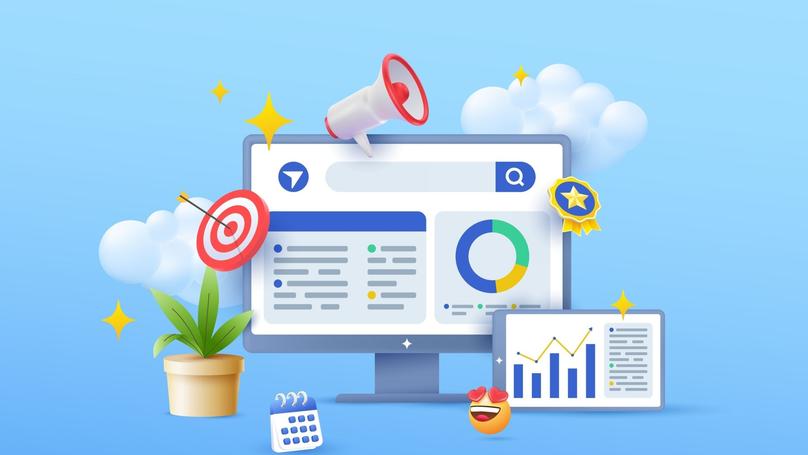Marketing

What is marketing
Marketing is a set of methods and technologies for promoting goods and services and strategies for interacting with customers, personnel, suppliers, and other counterparties to make a profit. In fact, there are more than a thousand definitions of marketing. However, according to the most generalized term, marketing is a set of measures to sell products that benefit both the business and the target audience, as well as concepts and tools that allow you to achieve those results. Therefore, marketing is considered an essential business function in which many specialists are involved - from contextual specialists and Big Data analysts to content creators. Small or medium-sized businesses may have just one marketer, but large businesses tend to have a whole staff of promotion specialists.
The key tasks of marketing involve determining potential consumers' needs, satisfying them, and making a profit. Moreover, marketers are engaged in market analysis, developing new products, forming pricing policies, increasing sales, and creating and maintaining a brand image.
What other functions does marketing perform?
The functions of marketing are the areas that allow you to fully reveal the potential of the business and expand its geography and scale while increasing sales and profits. Among the main functions are:
- Analytical. It involves the study of the market, competitors, consumers, and manufactured goods, as well as the company itself, its structure, and its internal environment. Marketers need to understand what customers need, how to meet their needs, and how to make a competitive product while constantly increasing profits.
- Production. After marketers have identified the target audience's needs and determined customers' expectations of the product, it is necessary to develop a product that meets their interests, desires, and capabilities and can confidently compete with similar products from other manufacturers. Thus, this function includes the organization of production, procurement, control, and quality control.
- Sales function. Simply put, a marketer must do everything to sell as much as possible. For this purpose, promotion specialists develop systems for generating demand, stimulating the sale of goods, improving customer service, and creating an attractive pricing strategy. Thus, the sales function allows a business to offer products at the right time and place and manage the assortment and relations with the audience. Receiving feedback and improving a product based on it is also part of this process.
- The function of control (or management). This means developing a general brand strategy, monitoring the achievement of KPIs, choosing priority areas for work, optimizing production processes, and maintaining prompt communication and information exchange. Yes, all this falls on the shoulders of the marketers! Promotion specialists need to be able to achieve their goals with minimal risks.
Thus, marketing functions are a whole system of interrelated elements, each striving to obtain maximum benefit at the least cost and loss.
Marketing goals and objectives

As we have already found out, marketing aims to get as much profit as possible at a minimum cost. Management theorists and experienced managers identify several tasks that promotion specialists face. For example:
- to achieve the maximum level of product consumption;
- achieve maximum customer satisfaction with the product;
- to provide customers with a wide range of products;
- improve customers' quality of life and solve their problems with the help of the product.
Marketing is used to achieve all these goals simultaneously. Nevertheless, there is also the most general formulation: a global goal that includes all of the above is "to make sales efforts unnecessary, to get to know the customer so well that goods and services sell themselves." The economist and researcher Peter Drucker said the same. Even in the last century, his idea sounded like an absolute utopia. However, even now, thanks to the latest technologies, the functionality of generative artificial intelligence, and a variety of neural networks, there are more and more opportunities to create personal sales offers for each consumer to satisfy even the most hidden and secret desires of the client. Moreover, the most accurate and reliable forecasting and planning tools are emerging, facilitating promotion specialists' work and making it easy to solve tasks.
According to another classification of marketing tasks, they include:
- research of the needs and interests of the potential audience;
- development of new products that meet the desires and capabilities of customers;
- analysis of the market in a specific niche;
- forecasting the development and modifications of the market;
- competitor research and competitiveness;
- development of pricing and assortment policy;
- establishing sales;
- maintaining the brand image.
That is, marketing aims to perform all the abovementioned tasks with the most outstanding efficiency.
Types of marketing
There are a vast number of marketing classifications. Let's consider a few of the most common ones. So, depending on the nature of demand in the market, the following are distinguished:
- Conversion marketing. It is used to influence negative demand, form a positive image of the product or brand, and change consumers' attitudes toward the product by improving it, for example, by adding new features, simplifying functionality, or reducing cost.
- Incentive marketing involves creating or increasing demand for a product that is unavailable. But before creating interest among the target audience, you should determine why it is indifferent to your product and how to overcome this obstacle effectively.
- Developmental marketing is used to identify potential and hidden demand and predict what product will be in demand among future customers. The purpose of such marketing is primarily to create the most effective product or service that would turn the latent demand in the market into a real one.
- Supportive marketing is necessary to ensure that the sales level stays the same. Even if the demand for the product is stable and the company's capabilities correspond to its level, it is necessary to maintain the audience's interest, gradually improving improve the product, and remaining remain competitive in the market.
- Countermarketing is used to reduce demand (yes, this also happens!), which exceeds the supply for goods that have a negative impact on society and the environment. These are tobacco products, alcohol, goods made of non-recyclable plastic, and similar materials.
- Remarketing is needed to revive demand literally. A product is actively stimulated, preventing its exit from the market.
- Demarketing also involves a decrease in demand, as does countermarketing. However, it is used only if the company does not have enough production capabilities to satisfy it. Such a result can be achieved by increasing the cost of the product or by reducing the volume of advertising and promotion efforts, but only its balance.
- Synchromarketing is also used to balance demand. For example, this indicator cannot avoid fluctuations if the offered product is seasonal. Therefore, marketers develop a flexible price policy and other sales incentives, such as discounts and promotions.
Depending on the market coverage and scale of a company's activities, there are several types of marketing. It can be:
- Mass marketing, which is aimed at the broadest range of consumers. Typically, this is used to promote products that are essential to everyone, such as food items. In this case, it is even possible to disregard the differences between representatives of the target audience, as mass marketing aims to outpace competitors and offer a relevant product at a low price.
- Differentiated marketing, which cannot be called "marketing for everyone." It is aimed at a substantial part of the market but not the entire niche. Differentiated marketing covers certain segments of the potential audience and creates a unique product promotion strategy for each of them, taking into account the needs, desires, and capabilities of the representatives of these segments.
- Targeted marketing, which is most often used in small businesses to quickly capture the attention of a specific audience segment and effectively meet their needs.
Moreover, marketing was classified depending on which consumers it affects. Thus, there are:
- B2B marketing (or Business-to-Business), when one company sells its product or service to another company;
- B2C (Business-to-Client) when a company sells its product or service to an end consumer, or an individual, rather than a legal entity;
- B2G (Business-to-Government), when the company's products or services consumer is a government agency or structure.
By now, there are several dozen more types of marketing, identified on the basis of the tools used. For example, there is traditional and digital marketing. Traditional is a fundamental direction in the promotion of goods and services, the meaning of which is to analyze the target audience, identify its interests, search for pain points and meet needs. Digital marketing refers to methods of promoting products and increasing profits that are primarily used in the digital environment. For example, this includes search engine and email marketing, SEO optimization, targeted advertising, and so on.
Promotion in social networks is carried out by representatives of another type of marketing - SMM (or Social Media Marketing). Influence marketing is no less common on the Internet. Influencer marketing is used to strengthen brand positions, increase customer loyalty, and boost sales through opinion leaders, bloggers, and celebrities. Potential consumers tend to trust advertisements more if they see their favorite artist or singer in them. Thus, they are more likely to buy a product promoted by a celebrity than the same product seen on television. Content marketing is equally common. This method of promotion involves using useful or entertaining content, such as blog articles, social media posts, educational webinars, lectures, and other videos.
With the development of the latest technologies, neuromarketing has also appeared, which primarily studies the behavior and psychological characteristics of buyers, including their hidden motives, preferences, and needs. Thus, with the help of special marketing research, scientists record and study the reactions of the brain to a certain product, tracking the processes that occur at the unconscious level. building further communication with consumers depending on the data received about their hidden motives and desires.
Companies often use buzz or hidden marketing to maintain interest and hype around the brand. Its essence is to make potential buyers talk about the brand as much as possible, discussing scandalous theories or leaked information, thereby helping the company remain on the radar. By the way, branding is also called one of the marketing strategies because it is aimed at making consumers want to buy and use a product of a certain brand.
In the post-COVID era, event marketing, also known as experiential marketing, is gaining momentum again. This involves organizing various events on behalf of a brand or company in which customers themselves participate. This gives them the opportunity to become part of a well-known brand, feel a sense of belonging, and recognize their importance and value to the company.
Affiliate marketing provides additional opportunities to attract new audiences and customers. This is the promotion of goods and services through intermediaries or partners for mutual benefit. For businesses, this is a great way to get a new audience, an additional source of income, and traffic on social networks with the help of previously inaccessible resources.
What other strategies are used in marketing?

A marketing strategy is a certain plan or sequence of actions that are necessary to promote a product, increase profits, and achieve all of the goals listed above. Each such strategy necessarily contains the following components:
- product,
- price,
- promotion,
- place.
These are called the 4Ps, the marketing mix, or the "pillars" of marketing. A strategy begins with the study of the product and the formation of a pricing policy, followed by promotion and distribution processes. Other versions of this concept, such as the 5Ps and 6Ps, similarly divide marketing into several such components.
As a rule, companies independently develop unique strategies depending on the field of business activity, its scale, and its target audience. However, there is also a generalized classification:
- Global
They involve increasing the company's presence in the market, entering the foreign market and strengthening the company's position in it, increasing sales, forming the widest possible range, developing new directions, and cooperating with other large companies and industries.
- Basic, or fundamental
They include creating a unique selling proposition and distinctive brand characteristics, achieving leadership in a certain market segment, reducing costs, and thereby increasing profits. Therefore, basic strategies are primarily related to the company's positioning.
- Competitive
They determine how the company will interact with other market participants. For example, the leadership strategy is to always try to be one step ahead of competitors, enter those markets in which there are no leaders yet, and change prices for goods in order to shake the leadership positions of other companies.
- Growth Strategies
As a rule, they aim to expand the business's geography and production capacity, constantly increasing sales and market share. Growth strategies include, for example, diversification, that is, the sale of new products in new markets. Also, the growth strategy may include the acquisition of another company to expand activities.
Thus, the choice of strategy depends on what goals the company needs to achieve in the first place. As a rule, experienced managers use several strategies at once to achieve the most effective and fastest result. For example, they increase their presence in the market and complement the product's functionality while always trying to stay ahead of competitors and get closer to leadership in their niche. Thus, IKEA follows the differentiation strategies, that is, it focuses on differentiating from similar products and cost leadership, which involves optimizing processes and reducing costs, thereby reducing the price of products and attracting an even larger audience.
Nevertheless, an inexpedient combination of three or more strategies can lead the company to bankruptcy. After all, the development and improvement of the product require considerable investment. If, at the same time, you reduce the price of the product and keep the focus only on a highly specialized niche with a small audience, the investment may not pay off at all.
A few more examples of marketing strategies
Recall the innovative company Apple. It uses two key marketing strategies: product differentiation and diversified growth. The first involves creating products and services that are fundamentally different from similar products from competitors and focusing customer attention on Apple's main differences and advantages. At the same time, they follow a strategy of diversified growth, that is, they expand their product lines and directions. In summary, Apple:
- provides a unique customer experience;
- focuses on revolutionary solutions, for example, paying for any purchases with a smartwatch;
- expands the product line within a single brand ecosystem;
- forms a unique pricing policy (the company never uses discounts and promotions to stimulate consumer demand);
- actively uses cross-selling, offering to buy headphones, watches, or subscribe to an online service in addition to buying an iPhone.
By the way, Nike follows the same strategy of diversification and horizontal growth, that is, expanding the range of products. In the process of its development, it launched more and more new directions, producing shoe models for a variety of activities.
Netflix follows a global strategy of internationalization, or entering new foreign markets. The company started as a DVD rental service but soon offered its customers subscriptions. Later, with the development of streaming platforms, Netflix created its own online cinema, offering unlimited content at affordable prices.
Marketing tools

There are many different marketing methods and tools, without which it would remain only a theoretically written strategy that does not bring profit. Let's consider the most common of them that allow businesses to generate interest in their products, attract and retain the attention of customers, and motivate them to buy again and again.
One of the most important tools of traditional marketing is outdoor advertising. This is the most familiar format of communication, in which advertisements and messages for the audience are placed in public places, such as shopping centers, bus stops, public transport, and huge billboards. In general, such advertising ensures brand recognition because it provides good coverage and is remembered by potential consumers.
Both traditional and Internet marketing often use sales promotion. This includes various campaigns, sales, discounts, and contests among consumers. This tool also involves distributing product samples, organizing tastings, or hosting various workshops. All these efforts help to sell more products immediately.
Another effective tool for engaging with the audience is sensory marketing. This is a unique method of promoting goods and services by stimulating the senses of potential customers. For example, the smell of fresh baked goods in a supermarket or the aroma of coffee encourages visitors to buy them, boosting sales. Additionally, sensory marketing involves visual stimulation, such as a specific logo or brand colors, and auditory elements, like appropriate music in a shopping mall, beauty salon, or café.
Contextual advertising is most commonly used in digital marketing. Users easily perceive it since it appears only in response to a specific query. For example, this is the kind of advertising you see in search engines. Contextual advertising's advantage lies in its ability to focus on a certain target audience segment. Thus, interaction with already interested customers is more successful, while advertising costs are significantly reduced.
Search engine optimization, or site content optimization, is actively used to ensure that your ads appear as high as possible in the search results for queries closest to the company's activities. This is one of the most effective ways of promotion since search engines' audience significantly exceeds any other Internet resources.
In addition, one of the first tools of online marketing is still used-email newsletters. With the help of emails, the company can regularly communicate with customers and inform them about promotions, discounts, and new assortments. This is a great way to remind yourself about yourself, encourage the target audience to buy, and make a personalized offer. For this tool to be effective, it needs a customer base with email addresses.
Targeted advertising is also frequently used. These ads on social networks are shown to specific users who match the advertiser's essential characteristics. This tool is based on pre-selecting the audience and then displaying relevant ads. To achieve this, marketing specialists study consumers' characteristics, such as age, location, interests, and needs.
Therefore, like contextual advertising, targeting allows focusing on a specific group within the target audience based on the information available about its representatives on social networks. Although targeted advertising works with colder potential clients, it still effectively addresses business objectives. For example, it actively attracts subscribers to the brand's official accounts.
SMM, or Social Media Marketing, is another tool for promoting a brand's products and strengthening its position in the market. We can say that this is marketing integrated into various social platforms. So, the more potential customers follow the company's social networks and share feedback through likes, comments, and reposts, the more trust the brand will arouse among new consumers.
In addition to SMM, unobtrusive product promotion also involves native advertising. This message describes a product or service seamlessly and almost invisibly integrated into content that is interesting to the target audience, such as an article, video, review, etc. Thanks to such advertising, users do not feel like they are watching promotional material.
The main advantage of native advertising is its ability to attract the attention of many users, maintain a high level of trust and loyalty to the brand, and increase conversion rates.
Viral advertising. Interestingly, users themselves share such ads. These can be posts on social networks or videos on YouTube, which the audience actively forwards, likes, and comments. All this naturally increases brand awareness on the Internet. The main thing is to adhere to the principles of creating viral advertising, creating content that will cause a strong emotional reaction from users and stimulate them to action. A "viral" video can reach a multi-million audience at the lowest cost.
By the way, video advertising is a separate promotion tool most often used by online cinemas and various hosting platforms like YouTube. Advertising messages should be organically embedded in the video that the potential consumer starts watching.
Experienced marketers use newsjacking to integrate advertising into the modern agenda skillfully. This technique uses real events to promote or advertise a product or brand. Newsjacking is considered a type of guerrilla marketing, a strategy in which businesses use creative ideas for promotion and achieve broad reach with minimal investment. For example, one of the most common news topics in recent years was COVID-19. Recall how many brands launched new product lines related to the coronavirus. This is a case where the relevance and timeliness of the news are crucial, and the resulting newsjacking content resonates with everyone.
In fact, SMM, native, and video advertising should follow the principles of storytelling. In some classifications, storytelling is singled out as a separate promotion tool, but in reality, high-quality advertising always involves storytelling techniques. Storytelling is the name given to the promotion of products through stories. It inspires more consumer trust, makes the product more tangible, and makes the company humane, understandable, and close to the audience.
Conclusions
Thus, marketing is an incredibly broad field of activity in which creative specialists, content creators, and analysts are needed. Many marketing tools, methods, and strategies exist to get the most complete coverage of the audience, keep its interest and attention, increase trust and loyalty, and sell as much as possible.























